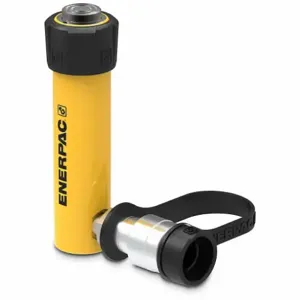- Enerpac 53, RC-Series general purpose hydraulic ram for lifting heavy loads using hydraulic pumps in metalworking and maintenance & repair applications
- Heavy-duty pre-tensioned spring for improving retraction speed and GR2 bearing design for reducing wear & ensuring durability
- Alloy steel construction offers high strength & baked enamel finish protects against corrosive fluids & chemicals
- Plunger wiper for protection against external contamination, base mounting holes for easy fixturing & cylinder thread protector for ease-of-use
- Includes CR-400 coupler and dust cap for covering the port when not in use
- Features round body with single piston rod for use in general purpose applications in all positions
Features:
- It features a heavy-duty pre-tensioned spring for improved retraction speed and a GR2 bearing design for enhanced durability.
- This hydraulic cylinder have alloy steel construction for high strength and baked enamel finish to protect against corrosive fluids and chemicals.
- It is equipped with a plunger wiper for protection against external contamination, base mounting holes for easy fixturing and a cylinder thread protector for ease-of-use.
- This hydraulic cylinder is integrated with a round body and single piston rod, making it suitable for general-purpose applications in all positions.
Frequently Asked Questions:
Q. How to install this Enerpac RC-53 general-purpose hydraulic cylinder?
A.
- Identify the suitable mounting location and ensure it can accommodate the size and weight of the hydraulic cylinder.
- Prepare the mounting surface by cleaning and removing any debris or obstructions.
- Position the hydraulic cylinder in the desired location, aligning the base mounting holes with the corresponding holes on the mounting surface.
- Securely attach the cylinder to the mounting surface using appropriate bolts or screws, ensuring a tight and stable connection.
- Ensure the cylinder is properly aligned and level to prevent any misalignment or strain during operation.
- If necessary, apply thread sealant to the cylinder's connections to ensure a leak-free installation.
- Connect the hydraulic hoses or fittings to the cylinder's ports, ensuring proper tightening and sealing to prevent fluid leaks.
- Test the cylinder's operation by slowly and gradually applying hydraulic pressure, checking for any abnormalities or leaks.
- Once the installation is complete and the cylinder is functioning properly, perform a final inspection to verify the stability and integrity of the installation.
Q. What factors should be considered while choosing a hydraulic cylinder?
A.
- Application requirements: Evaluate load capacity, operating pressure and stroke length.
- Cylinder type: Choose between single-acting or double-acting cylinders based on desired functionality.
- Mounting style: Consider space and options like tie-rod, welded or flange-mounted cylinders.
- Operating conditions: Evaluate environment, temperature, humidity and corrosive substances for suitable seals and materials.
- Quality and reliability: Select cylinders from reputable manufacturers known for high-quality and reliable products.
- Maintenance and serviceability: Assess ease of maintenance, spare part availability and technical support.
- Cost: Consider initial and long-term expenses, including maintenance, repairs and energy consumption.
- Safety features: Look for cylinders with pressure relief valves, position sensors and emergency stop functions for safe operation.
Q. What is the difference between a single-acting and a double-acting hydraulic cylinder?
A. A single-acting hydraulic cylinder has one hydraulic port and uses hydraulic pressure to extend the piston, relying on an external force (like gravity or spring) to retract it. In contrast, a double-acting hydraulic cylinder has two ports, enabling hydraulic pressure to extend and retract the piston, providing bi-directional movement.









